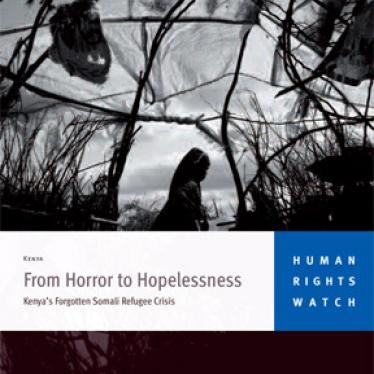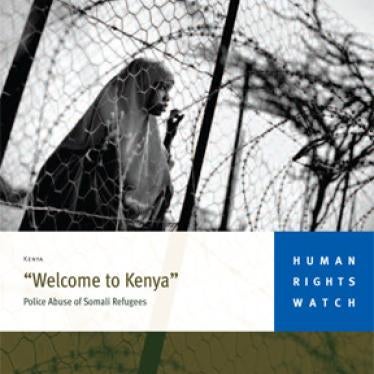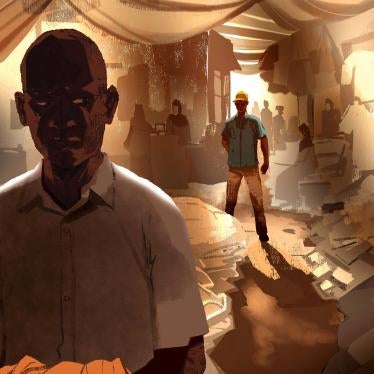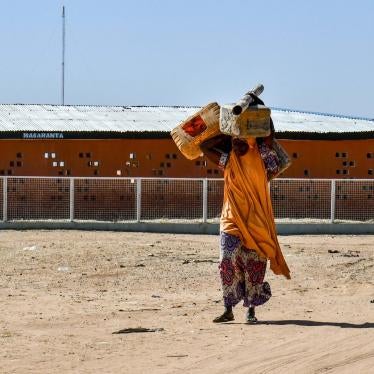(Nairobi) – The Kenyan government should urgently provide land for new refugee camps in response to the humanitarian crisis in existing camps near its border with Somalia, Human Rights Watch said today. Kenya should also allow recently arrived Somalis fleeing drought and conflict to seek shelter in an unused refugee camp, and stop saying assistance should only be provided in Somalia, Human Rights Watch said.
Almost 100,000 Somali refugees have arrived in Kenya since January, currently about 1,300 a day. This brings the total number of refugees, most of them Somalis, living in inhuman conditions in Kenya’s Dadaab refugee camps to nearly 400,000. The camps were originally built for 90,000 people. However, Kenyan authorities have refused to open the “Ifo extension” camp, which has been ready to take refugees in since November 2010, and have failed to identify urgently needed additional land to reduce crowding in the existing camps. Kenyan authorities have also said that refugees fleeing drought since early this year should be assisted inside Somalia.
“Kenyan government statements that Somali refugees are fleeing only famine and not conflict, or that Somalia is now safe, are just plain wrong,” said Daniel Bekele, Africa director at Human Rights Watch. “Kenya is clearly shouldering a huge burden, but instead of saying that Somalis should stay home it should re-affirm its commitment to welcome and assist Somalis in Kenya.”
Four years after the United Nations High Commissioner for Refugees (UNHCR) first started negotiations on land for new camps, Prime Minister Raila Odinga of Kenya announced on July 14, 2011, that UNHCR could use the Ifo extension camp – with an official capacity of around 40,000 people – to shelter some of the refugees. Yet two weeks later, only a handful of refugees have been allowed to relocate to the edge of the extension site.
Human Rights Watch said that Kenya undoubtedly faces huge challenges in hosting at the Dadaab and Kakuma camps almost 400,000 Somali refugees, who may only leave the camp in exceptional cases. A similar number of refugees are believed to be living in Kenya’s two largest cities, Nairobi and Mombasa, 95 percent of them illegally.
In its 2009 report “From Horror to Hopelessness,” Human Rights Watch documented the appalling conditions caused by overcrowding in the Dadaab camps, including an overwhelmed sanitation infrastructure, inadequate shelter, limited access to water, and poor health care. Human Rights Watch called on the UN and Kenya to earmark more land for new camps.
With 400,000 refugees in Dadaab living on land for 90,000 and with some 40,000 potentially to be relocated to Ifo extension camp, Human Rights Watch said that Kenya needs to provide additional land to shelter at least 300,000 refugees to ensure that they are accommodated according to minimum shelter standards and to provide room for new arrivals in the months to come.
“Either Kenya should respect Somali refugees’ right to freely move throughout the country or, at the very least, ensure they live in acceptable camp conditions,” Bekele said. “The math is unfortunately clear: acceptable shelter conditions mean more land for at least 300,000 refugees.”
An official government statement on July 21, echoing others by government ministers, said the solution to the refugee influx was not to be found in Kenya alone and that refugees should be assisted in other countries, notably in Somalia itself. The official statement also claimed that the refugees were fleeing only drought and not conflict.
Under international law, the need to assist and protect people in the country of origin does not absolve a refugee-receiving country of its obligation to protect refugees, Human Rights Watch said. It also rejected the claim that recently arrived refugees are simply drought victims who can be helped inside Somalia. The famine and the conflict are intimately linked, Human Rights Watch said.
The government’s statement that refugees would be safe inside Somalia is an implied reference to a newly created “buffer zone” in Somalia, which Kenya has supported to stem the flow of refugees and illegal weapons into Kenya. The area is not an adequate safe haven for internally displaced Somalis, Human Rights Watch said.
To create a buffer zone, Kenya supported the deployment between March and May of a militia it had trained to fight alongside Somalia’s Transitional Federal Government forces to remove the Islamist insurgent group al-Shabaab from areas in Somalia along the border with Kenya, in particular around the town of Dhobley. Al-Shabaab controls much of southern and central Somalia.
The fighting, however, displaced tens of thousands of civilians, many of whom fled to Kenya. The resulting buffer zone – around 80 kilometers wide and 100 kilometers long, runs north-south opposite parts of Kenya’s Northeastern Province, including the Dadaab camps. Its self-appointed president, Professor Abdi Gandhi, refers to it as the semi-autonomous region of Azania, also known as Jubaland.
Although al-Shabaab has left the buffer zone, the situation there remains highly unstable and insecure, Human Rights Watch said. Kenyan government assurances that the area is “conflict free” or capable of providing a safe haven to potentially hundreds of thousands of internally displaced persons are unsubstantiated.
“Well over a million civilians affected by the conflict including displaced people inside Somalia desperately need aid,” Bekele said. “Even if assistance is provided inside Somalia, Kenya should not use that as an excuse to shirk its obligations to assist and protect Somali refugees.”
Human Rights Watch said that although the Kenyan authorities have valid concerns about the environmental and security impact of the refugee influx, this does not justify their unwillingness to establish more camps or their suggestion that recently arriving refugees should be assisted back in Somalia. Preventing refugees from entering Kenya or sending them back to camps in Somalia would violate Kenya’s obligations under international law, Human Rights Watch said. The 1969 African refugee convention, in particular, proscribes “rejection at the frontier” and recognizes as refugees not only people fleeing persecution but also “events seriously disturbing public order in either part or the whole” of their country.
Human Rights Watch also said that despite the large numbers of Somali refugees in the Dadaab camps, the Kenyan government has pursued restrictive policies toward Somali asylum seekers for several years, often citing general security concerns.
In January 2007, the Kenyan authorities officially closed the border with Somalia, making no exceptions for asylum seekers, who under Kenyan law are entitled to enter Kenya and apply for asylum. The border closing forced UNHCR to shut down its refugee reception center in the Kenyan border town of Liboi. The vast majority of Somalis enter Kenya through Liboi before travelling to the Dadaab camps 90 kilometers away.
The transit center – where all refugees were registered and given health checks before being safely transported to the camps – remains closed. As a result, tens of thousands of asylum seekers since 2007 have had to use smuggling networks to cross the porous border into Kenya and to reach the camps through scrubland to avoid Kenyan police and bandits.
Human Rights Watch, in its June 2010 report “Welcome to Kenya: Police Abuse of Somali Refugees,” found that in early 2010 alone, hundreds, and possibly thousands, of Somalis unable to pay police extortion demands were sent back to Somalia. The forced returns violated Kenyan and international law, which forbids the forcible return of refugees to persecution, torture, or situations of generalized violence. The government formed a special investigation team to look into police abuses, including rape, and police failures to prevent criminals from attacking asylum seekers as they travel from the border to the camps, but the team’s findings have not been published.
Human Rights Watch’s 2010 report also documented Kenya’s illegal policy of prohibiting the vast majority of refugees registered in the camps from traveling to other parts of Kenya, unless they have special permission for reasons such as medical appointments or education in Nairobi. Under international law, Kenya must justify any such prohibition as the least restrictive measure necessary to protect national security, public order, or public health, which it has failed to do. In 2009, the authorities allowed only 6,000 of Dadaab’s almost 300,000 refugees to travel outside the overcrowded camps.
“Kenya’s unwillingness to provide more land and its suggestion that Somalis should stop seeking refuge in Kenya follows years of restrictive policies toward Somali refugees,” Bekele said. “Kenya should use this opportunity to change course and to harness international support to assist and protect desperate Somalis in Kenya.”








